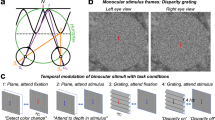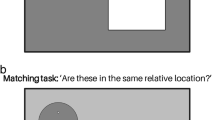Abstract
The visual mechanism by which human observers determine the separation between objects has long been of interest. This study examines the extent to which separation in visual space can be misperceived in foveal and extrafoveal vision. Foveally, vertical separations were consistently overestimated relative to horizontal separations, a result which is consistent with the well-documented horizontal-vertical illusion (HVI). Extrafoveally, much larger misrepresentations of visual space were perceived. In addition, separations tangential to fixation were consistently perceived as being greater than separations in a radial direction. These marked misperceptions of visual space which occur in extrafoveal vision take the form of a radial/tangential anisotropy combined with an overestimation of vertical distance. The results have important implications for meridional anisotropies which have previously been documented in a number of visual performance tasks.
Similar content being viewed by others
Author information
Authors and Affiliations
Additional information
Received: 17 July 1998 / Accepted: 14 October 1998
Rights and permissions
About this article
Cite this article
McGraw, P., Whitaker, D. Perceptual distortions in the neural representation of visual space. Exp Brain Res 125, 122–128 (1999). https://doi.org/10.1007/s002210050667
Issue Date:
DOI: https://doi.org/10.1007/s002210050667




